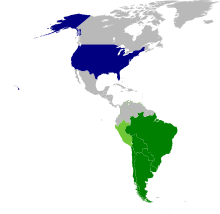兀鹰行动
(重定向自兀鹰行动)
此条目需要补充更多来源。 (2019年6月14日) |
兀鹰行动(西班牙语:Operación Cóndor,葡萄牙语:Operação Condor,英语:Operation Condor)是一项由美国支持、在南美洲搜集情报和暗杀对手的政治迫害和国家恐怖主义行动。[8]它于1968年开始,1975年在南美洲南锥体的右翼独裁国家正式实施,领导人有豪尔赫·拉斐尔·魏地拉、乌戈·班塞尔、翁贝托·德·阿伦卡尔·卡斯特略·布朗库、阿图尔·达科斯塔·伊·席尔瓦、奥古斯托·皮诺切特、弗朗西斯科·莫拉莱斯·贝穆德斯、阿尔弗雷多·斯特罗斯纳和阿帕里西奥·门德斯。它的目的是铲除共产主义与苏联的影响,并抑制成员国政府的反对派运动。
| 兀鹰行动 | |
|---|---|
| 冷战的一部分 | |
 (深绿色)主要成员︰ 阿根廷、玻利维亚、巴西、智利、巴拉圭、乌拉圭 (浅绿色)其他成员: 哥伦比亚、秘鲁、委内瑞拉 (蓝色)主导者及财政支援者:美国 | |
| 行动种类 | 隐蔽行动 |
| 地点 | 南美洲 |
| 目标 | 左派同情者(包括裴隆主义、共产主义者和社会主义者)以及南美军政府的反对者 |
| 作战单位 | 各参与国的情报机构 |
| 计划者 | 支持: |
| 指挥者 | 支持: |
| 日期 | 1968–1989年 |
| 结果 | 行动在柏林墙倒塌后结束 |
| 伤亡人数 | 60,000-80,000名左翼同情者被处决[7] 400-500人在跨境行动中丧生[7] 超过40万名政治犯 |
由于其秘密性质,兀鹰行动直接造成死亡的人数备受争议,保守估计至少有60,000人死亡,其中大约30,000人死在阿根廷,受害者包括政坛的异见人士及左翼分子、工业及农业界组织的领袖、天主教会的神父和修女、学界的知识分子及师生、游击队员以及任何被怀疑反政府的人士。[9][10]
兀鹰行动的主要成员国包括阿根廷、智利、乌拉圭、巴拉圭、玻利维亚和巴西。[11][12]美国多任政府都为军政府提供了技术支持、酷刑培训和军事援助,包括约翰逊、尼克松、福特、卡特和里根政府,[13]这种支持经常通过中央情报局提供及协调。[13]
参考文献
编辑- ^ McSherry, J. Patrice. Chapter 5: "Industrial repression" and Operation Condor in Latin America. Esparza, Marcia; Huttenbach, Henry R.; Feierstein, Daniel (编). State Violence and Genocide in Latin America: The Cold War Years (Critical Terrorism Studies). Routledge. 2009: 107, 111 [2022-01-29]. ISBN 978-0415664578. (原始内容存档于2018-07-19).
- ^ Greg Grandin (2011). The Last Colonial Massacre: Latin America in the Cold War (页面存档备份,存于互联网档案馆). University of Chicago Press. p. 75 (页面存档备份,存于互联网档案馆). ISBN 9780226306902.
- ^ Walter L. Hixson (2009). The Myth of American Diplomacy: National Identity and U.S. Foreign Policy (页面存档备份,存于互联网档案馆). Yale University Press. p. 223 (页面存档备份,存于互联网档案馆). ISBN 0300151314.
- ^ Maxwell, Kenneth. "The Case of the Missing Letter in Foreign Affairs: Kissinger, Pinochet and Operation Condor". David Rockefeller Center for Latin American Studies (DRCLAS), Harvard University. 2004 [2022-01-29]. (原始内容存档于2022-05-05) (英语).
- ^ Dalenogare Neto, Waldemar. Os Estados Unidos e a Operação Condor. 2020-03-30 [2022-05-30]. (原始内容存档于2022-05-05).
- ^ McSherry, J. Patrice. Operation Condor: Clandestine Inter-American System. Social Justice. 1999, 26 (4 (78)): 144–174 [2022-01-29]. ISSN 1043-1578. JSTOR 29767180. (原始内容存档于2022-05-05).
- ^ 7.0 7.1 Bevins, Vincent. The Jakarta Method: Washington's Anticommunist Crusade and the Mass Murder Program that Shaped Our World. PublicAffairs. 2020: 266–267. ISBN 978-1541742406.
- ^ Blakeley, Ruth (2009). State Terrorism and Neoliberalism: The North in the South (页面存档备份,存于互联网档案馆). Routledge. ISBN 0415686172
- ^ Victor Flores Olea. Editoriales – Operacion Condor. El Universal. Mexico. 10 April 2006 [24 March 2009]. (原始内容存档于2007-06-28) (西班牙语).
- ^ Larry Rohter (January 24, 2014). Exposing the Legacy of Operation Condor (页面存档备份,存于互联网档案馆). The New York Times. Retrieved August 26, 2015.
- ^ Stanley, Ruth. Predatory States. Operation Condor and Covert War in Latin America/When States Kill. Latin America, the U.S., and Technologies of Terror. Journal of Third World Studies. 2006 [2021-09-17]. (原始内容存档于2008-12-29).
- ^ McSherry, J. Patrice. Chapter 5: "Industrial repression" and Operation Condor in Latin America. Esparza, Marcia; Huttenbach, Henry R.; Feierstein, Daniel (编). State Violence and Genocide in Latin America: The Cold War Years (Critical Terrorism Studies). Routledge. 2011: 108 [2022-01-29]. ISBN 978-0415664578. (原始内容存档于2018-07-19).
- ^ 13.0 13.1 Operation Condor: the cold war conspiracy that terrorised South America. the Guardian. 2020-09-03 [2021-10-06]. (原始内容存档于2022-05-17) (英语).
外部链接
编辑- 邱稔壤. 從政治外交層面看南錐禿鷹行動引發之人權爭議: 以智利皮諾契政權為例. 印刻出版. 2002年. ISBN 978-957-30142-7-0.